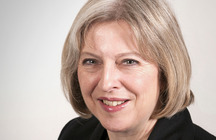The speech made by Theresa May, the Conservative MP for Maidenhead, in the House of Commons on 5 November 2020.
May I first say that I do not envy my right hon. Friend the Prime Minister and the Government the decisions that they are having to take and the difficult position they find themselves in? This pandemic has challenged Governments across the world, and Ministers have been under relentless pressure in dealing with this issue. However, just as Ministers are making tough decisions, so is Parliament, and Parliament will make better decisions if it is fully and properly informed.
I want to comment on the circuit breaker idea. I looked at the SAGE paper of 21 September and what was absolutely clear was that this was not a two-to-three-week circuit breaker, full stop, end of story. It would have had to have been repeated, possibly again and again, and I doubt if any economy could have borne the irreparable damage that would have done, with the impact on lives that that would have had, which would have been significant.
Of course the Government introduced the tiered approach. I would echo the comment made by my right hon. Friend the Member for Forest of Dean (Mr Harper) that one of the issues with that approach is that we have not had a proper analysis of its impact. The evidence from Liverpool shows that the number of cases is falling. I raised this in a briefing the other day and was told that that was because fewer students were coming forward to be tested. But when we look at the figures, we see that the number of cases is actually falling across the age ranges. We need a proper assessment of how the tiered approach is working.
There are other examples of figures being used in a way that I think has been unhelpful to Parliament and to the public. Let me take the 4,000 figure. The decision to go for this lockdown appears to have been based—partly, mainly or to some extent—on the prediction that there would otherwise be 4,000 deaths a day. But if we look at the trajectory shown in that graph, we see that we would have reached 1,000 deaths a day by the end of October. The average number of deaths in the last week of October was 259, by my calculation. Each of those deaths is a sadness and our thoughts are with the families, but it is not 1,000 deaths a day, so the prediction was wrong before it was even used. This leads to a problem for the Government, because for many people it looks as though the figures are being chosen to support the policy, rather than the policy being based on the figures. We need these proper analyses; we need to know the details behind these models; and we need to be able to assess the validity of the models.
There is one set of data that has not been available throughout. There is a lack of data on the costs of the decisions being made: costs in non-covid treatment in the NHS, and in non-covid deaths; costs in domestic abuse; costs in mental health, with possibly more suicides; and of course costs to the economy, with jobs lost, livelihoods shattered, businesses failing and whole sectors damaged. What sort of airline industry will we have as we come out of this? What sort of hospitality sector will there be? How many small independent shops will be left? The Government must have made that assessment, so let us see it and make our own judgments.
I want to make one point about public worship, echoing the concerns of others. My concern is that the Government today making it illegal to conduct an act of public worship, for the best of intentions, sets a precedent that could be misused by a Government in future with the worst of intentions, and that has unintended consequences. The covid-secure remembrance service in Worcester cathedral will now be turned into a pre-recorded online service. Surely, the men and women who laid down their lives for our freedom deserve better than that.
The public and Parliament want to support the Government to take the right decisions, and to do that we need to have the right figures, the right data and the proper information.
